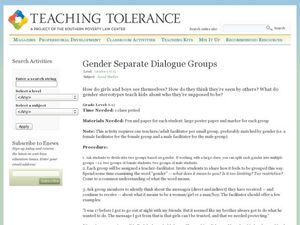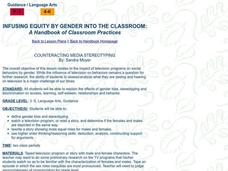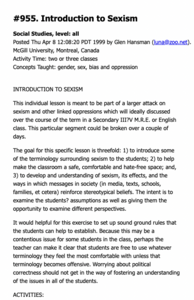Curated OER
CAN WE SWITCH GENDERS OF STORY CHARACTERS?
Analyze characters and stories to identify stereotyping. Learners will examine the concept of character gender to evaluate bias in classroom story books. They are asked to read a story or play and change the gender of the character to...
Curated OER
Gender Bias in Advertising
Learners view different paintings and discuss different advertisements that display gender bias, and redesign an advertisement found in a magazine, removing at least five aspects of the gender bias they find.
Curated OER
Infusing Equity by Gender into the Classroom
Students discover the biases between the two genders by comparing males and females in different species. For this gender identity lesson, students research National Geographic Magazine and view videos demonstrating the differences...
Curated OER
Exploring Gender Bias in the Workplace
Pupils investigate gender bias in the work place. In this secondary mathematics lesson, students gather research on the current statistics about a profession which focuses on the female//male ratios and the pay scale of the females...
Curated OER
Can Girls Be Plumbers? And Other Gender Stereotypes
Learners realize the effects of stereotypes by collaboratively creating a chart with the rest of their class. In this equality instructional activity, students demonstrate stereotypes by collaborating on a jobs chart and matching...
Mascil Project
Design and Build Your Own Vacuum Cleaner, Hair Dryer or Toy Car
No vacuum cleaner? No problem, just build your own. Scholars apply knowledge of currents to build a model of either a vacuum clear, a hair dryer, or a toy car. While the class completes the activity, instructors consider gender...
Curated OER
Gender Separate Dialogue Groups
Students complete studies to learn about tolerance for gender groups. In this gender study lesson, students are divided into gender groups and discuss how it feels to be grouped that way. Students brainstorm messages about what it means...
Curated OER
Can Girls Be Plumbers?
Students discover stereotypes in modern society. In this gender role instructional activity, students create a display of "school workers" and identify jobs as either male or female. The students discuss their choices and overcome...
Curated OER
The Gingerbread Person
Young scholars discuss gender bias and stereotyping. For this social science lesson, students read the book "The Gingerbread Boy" and discuss why it is a boy. Young scholars then write their own story changing it to a gingerbread girl...
National First Ladies' Library
Women's Lives in the Victorian Era
The lives of middle-class Victorian women were circumscribed by strict standards that governed all aspects of behavior. To gain a better understanding of the Victorian Ideals for women, class members research the life of a middle-class...
Curated OER
INFUSING EQUITY BY GENDER INTO THE CLASSROOM
Students identify careers that are nontraditional for their gender.
Curated OER
Infusing Equity By Gender Into the Classroom
Students identify careers that are nontraditional for their gender.
Curated OER
COUNTERACTING MEDIA STEREOTYPING
Students explore the effects of gender bias, stereotyping, and discrimination.
Curated OER
CHOOSING A CAREER - WITHOUT LIMITATIONS
Learners identify career areas that are not traditional for their gender.
Curated OER
Identification of Career Choices
Take some time to have your pupils identify careers that are not traditional for their gender.
Amnesty International
Respect My Rights, Respect My Dignity: Module One – Poverty and Human Rights
Creating an environment where learners feel both educated and empowered challenges any teacher when discussing a sometimes bleak topic. A respectful resource provides them with the details and permits them to make a plan of action....
Curated OER
Introduction to Sexism
Students develop an understanding of sexism, its effects, and the ways in which messages in society (in media, texts, schools, families, et cetera) reinforce stereotypical beliefs.
Curated OER
The Average Kid
Students determine the traits they have in common with other students in the class and create visual profiles of the "average" boy and the "average" girl.
Curated OER
Historical Witness - social Messaging
High schoolers examine and develop artwork that shows women's roles during different eras. In this women's role instructional activity, students look at artwork that shows women at work during the mid-nineteenth to early twentieth...
Curated OER
THAT'S A "GIRLS" JOB!
Students identify the differences in males and females and examine how sex roles are traditional.
Curated OER
Children's March Teacher's Guide, Activity 6
Students see the role that different genders played in the Civil Rights Movement in Birmingham. They explain how popular culture influences them.
Curated OER
Who Will Wear the Hats? Who Will Use the Tools?
Students recognize that there are many different jobs available in our society. They see that all people can, based upon an individual's natural abilities and interests, select any job regardless of gender.

























